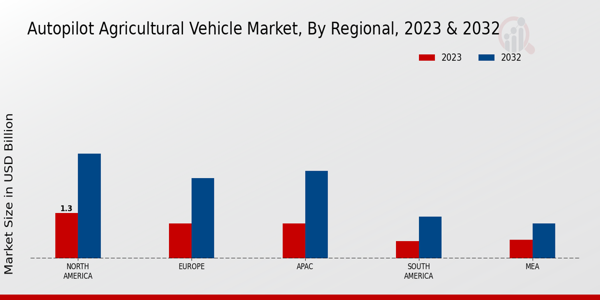Rising Labor Costs
In the Global Autopilot Agricultural Vehicle Market Industry, rising labor costs are a critical driver influencing the adoption of autopilot systems. As labor shortages become more pronounced in the agricultural sector, farmers are compelled to seek efficient alternatives to traditional labor-intensive methods. Autopilot agricultural vehicles offer a solution by reducing the dependency on human labor while maintaining productivity levels. This shift is particularly relevant in regions where labor costs have escalated, prompting a reevaluation of operational strategies. The anticipated growth of the market to 14.5 USD Billion by 2035 underscores the urgency for farmers to invest in automation technologies to remain competitive.
Market Growth Projections
The Global Autopilot Agricultural Vehicle Market Industry is characterized by robust growth projections. The market is expected to reach a valuation of 5.23 USD Billion in 2024, with a remarkable increase to 14.5 USD Billion by 2035. This growth trajectory indicates a compound annual growth rate of 9.72% from 2025 to 2035, driven by various factors such as technological advancements, rising labor costs, and increasing demand for sustainable agricultural practices. The anticipated expansion of the market highlights the growing recognition of the benefits of automation in agriculture, positioning autopilot vehicles as a vital component of future farming strategies.
Sustainability Initiatives
Sustainability initiatives are increasingly shaping the Global Autopilot Agricultural Vehicle Market Industry. Governments and organizations worldwide are promoting environmentally friendly practices, which include the adoption of autopilot vehicles that optimize resource usage. These vehicles can minimize fuel consumption and reduce greenhouse gas emissions, aligning with global sustainability goals. For example, countries are implementing policies that incentivize the use of precision agriculture technologies, further driving market growth. As a result, the market is expected to witness a compound annual growth rate of 9.72% from 2025 to 2035, reflecting a growing commitment to sustainable agricultural practices.
Technological Advancements
The Global Autopilot Agricultural Vehicle Market Industry is experiencing rapid technological advancements, particularly in automation and artificial intelligence. These innovations enhance the efficiency and precision of agricultural operations, allowing for better resource management. For instance, the integration of GPS and IoT technologies enables real-time monitoring and data collection, which can lead to improved crop yields. As farmers increasingly adopt these technologies, the market is projected to grow significantly, with a valuation of 5.23 USD Billion in 2024. This trend suggests a shift towards more sustainable farming practices, driven by the need for higher productivity and lower operational costs.
Government Support and Funding
Government support and funding are pivotal in driving the Global Autopilot Agricultural Vehicle Market Industry. Various governments are recognizing the importance of modernizing agriculture through automation and are providing financial incentives for farmers to adopt new technologies. Programs aimed at promoting research and development in agricultural automation are gaining traction, facilitating the introduction of innovative autopilot systems. This support not only encourages investment in advanced technologies but also fosters collaboration between public and private sectors. As a result, the market is poised for substantial growth, with projections indicating a valuation of 5.23 USD Billion in 2024, reflecting the positive impact of government initiatives.
Increased Crop Production Demand
The Global Autopilot Agricultural Vehicle Market Industry is significantly influenced by the increasing demand for crop production. As the global population continues to rise, the pressure on agricultural systems to produce more food intensifies. Autopilot agricultural vehicles play a crucial role in meeting this demand by enhancing operational efficiency and enabling farmers to cultivate larger areas with precision. This trend is particularly evident in regions with high agricultural output, where the integration of automation technologies is becoming essential. The market's projected growth to 14.5 USD Billion by 2035 indicates a strong alignment between technological adoption and the need for increased food production.























